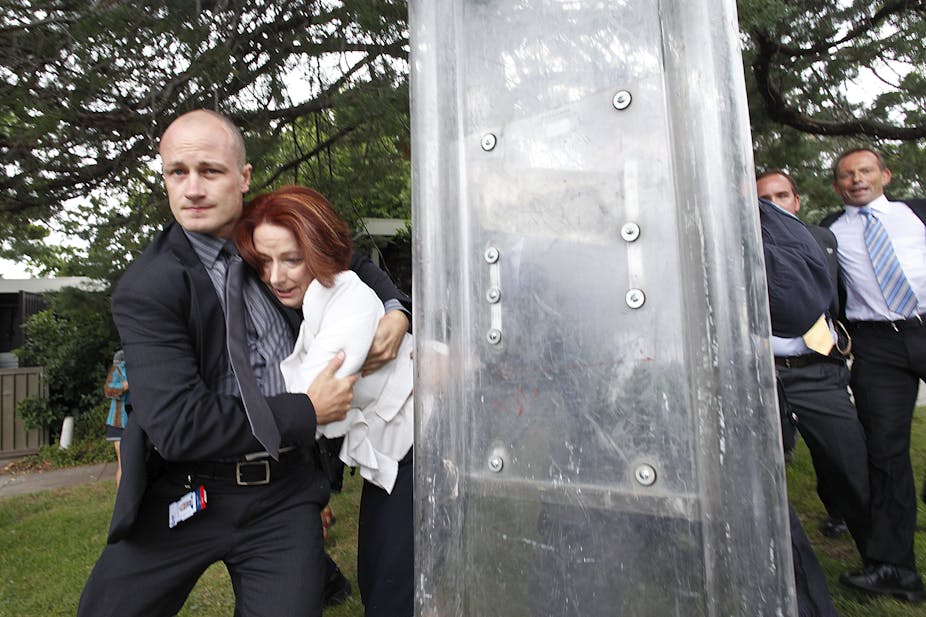Australia Day: cricket, beaches, prawns on the barbie, beer and a good dose of sunburn; a bit of jingoistic flag-waving, citizenship ceremonies and the conferring of awards to our most outstanding citizens and unsung heroes.
It all sounds harmless enough. A good family day out and warm fuzzy feelings of patriotism.
A darker history, however, is always lurking at the edges of this anniversary and it is a foolish politician who tries to diminish or discard that history. Yesterday’s protest in Canberra, resulting in the rushed evacuation of the Prime Minister and opposition leader from an awards ceremony, is just the latest indication of social tensions that no amount of green-and-gold clad kiddies and flag-bedecked cars can disguise.
Bureaucracy and barbecues
Australia Day is a bureaucratic anniversary. In 1788, the landing of the First Fleet and the raising of the British flag signalled the establishment of the British colony of New South Wales.
Since the bicentenary in 1988 organisers of Australia Day events and promoters of the day as a national celebration have stressed not the historical significance of the anniversary but the cultural and social significance of “being Australian”.
For Indigenous Australians the January 26 – Invasion Day or Survival Day – is viewed as a day of mourning for the land that was taken and the ensuing two centuries of social alienation and discrimination. From the raising of the British flag in 1788 to the Northern Territory intervention in 2007, successive governments have failed to reconcile the gap between Indigenous and immigrant Australia.
A problematic pitch
On January 27th, 1972, disgusted at the McMahon government’s refusal to acknowledge aboriginal land rights, a group of aboriginal activists marched on Canberra and established the Tent Embassy on the lawn opposite (Old) Parliament House. It was a powerful symbol. Strangers in their own country, the first nations established diplomatic representation to negotiate with government.
Powerful and effective. By 1975 the Whitlam government had recognised land rights and the Tent Embassy was dismantled and removed after negotiation between activists and the government.
It continued to operate from various locations and private houses in Canberra until 1992 when it was reestablished in its original location opposite Old Parliament House on the 20th anniversary of its founding. It has remained there ever since.
The embassy has always been a controversial symbol, not least within the broader Indigenous community. The Ngunnawal people, traditional owners of the land in and around Canberra, have always opposed its existence on their land.
No diplomacy in abuse
Yesterday’s protest was an ugly display of anger that will do nothing to assist the cause of the protesters. The trouble was the work of a relatively small group of people attending the Tent Embassy to mark its 40th anniversary.
Throughout the day I saw tweets and Facebook updates from friends and colleagues who enthused that it was a peaceful and friendly day of reminiscing and resolve. Aboriginal leaders and spokespeople have roundly condemned the few who attacked the restaurant and harassed the leaders. Attacking and abusing the Prime Minister and alternative prime minister is not diplomatic negotiation.
Tony Abbott’s comments earlier in the day, suggesting that the Tent Embassy may no longer be relevant and that we should move on, were ill-timed and insensitive. A recent immigrant himself, his readiness to dismiss the Tent Embassy as irrelevant was never going to be seen as anything but patriarchal at best and racist at worst.
However, he did make a point that should be part of our national conversation with regards to Indigenous rights.
Time for change?
Like most symbols, the Tent Embassy needs to have its role and relevance reviewed. This is not to diminish the importance of it as a symbol of aboriginal resilience and reminder of government neglect but to assess it in the socio-political context of 2012.
Much has changed since 1972 and much remains the same, but is the Tent Embassy still the most effective vehicle for negotiating that change?
Over the past few years Australia Day has become a flashpoint for trouble. A few years ago we saw flag-draped young people roaming around Manly making inflammatory and offensive remarks about migrants. This year we had former cricketer, Rodney Hogg, use Twitter to post an offensive anti-Muslim remark. The tweet was later deleted and Hogg claimed it was a bad joke and apologised but too late: the sentiment was out there. Instead of a day of unity and shared celebration, Australia Day has become a day of impunity for racists and nationalists.
Beneath a surface awash with national symbols and the pervading smell of charred sausages, there is an undercurrent of division and inequality that belies the happy, egalitarian culture that the day is meant to convey.
The Tent Embassy’s symbolic and practical relevance should be reviewed, but it is not up to Mr Abbott or any other elected representative to do that and, furthermore, it is not the only potentially divisive or controversial symbol in Australia that should be put under the social spotlight. The role of the monarchy should be questioned as well, for example.
As indeed should the relevance of Australia Day itself.

